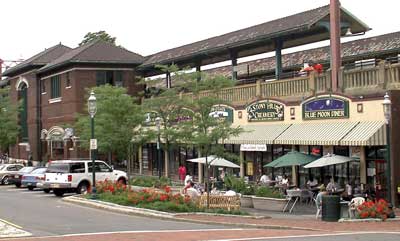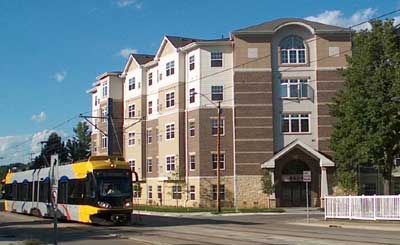Developers and employers think transit access is great. But if the hurdles are too high, they’ll forgo it -- choosing locations that shackle people to car dependence. That’s the finding of a recent report by University of Minnesota researchers Yingling Fan and Andrew Guthrie.

Fan and Guthrie propose a number of policy changes for the Twin Cities region to promote transit-oriented development. After all, they write, the region is planning to build a network of 14 transitways by 2030, and the success of these transitways hinges on attracting jobs and housing near the stations.
The success of these lines is crucial to the Twin Cities' regional growth plan, which envisions people making a greater share of their trips on transit. “In addition to attracting increased ridership," Fan and Guthrie write, "the regional transitway system is expected to serve as the anchor of a more sustainable future regional growth pattern of walkable residential communities and employment centers oriented to transit connections." These are no small goals, and guiding future development toward transit is critical for meeting them.
The region has its work cut out to halt the destructive development patterns it's seen recently, with the rise of major suburban employment centers in far-flung areas without transit access. And a study by the Center for Housing Policy in 2011 found that Minneapolis wasn't as successful as the other cities profiled at raising the value of transit-adjacent properties.
Fan and Guthrie conducted group discussions, online surveys, and in-depth interviews with Twin Cities developers and business leaders to learn their attitudes about transit-oriented development.
“Multifamily residential developers, redevelopment specialists, and large corporate office tenants already show strong interest in transit-accessible sites,” Fan and Guthrie write, but they often get thwarted by high land costs and needlessly complex regulations.
Those points are at the top of Fan and Guthrie’s very useful list of ways the Twin Cities can encourage TOD. The recommendations below are aimed at the Twin Cities but would undoubtedly be useful pointers for other cities and towns with similar goals.
Subsidize it: The higher costs of transit-accessible locations are a testament to the desirability of those sites, but they can also be prohibitive. Subsidies like TOD promotion grants or station-area tax abatement could help. But even better would be to...
Educate developers about the full costs of automobile dependency: Sure, a transit-accessible location might cost more per square foot. But developers need to think of the savings in other areas. Fan and Guthrie recommend using a “site-plus-transportation cost index” (like the Center for Housing Technology’s housing-plus-transportation, or H+T, index) to give developers and employers a more realistic overview of costs, including “parking, employee productivity impacts, and health insurance for a sedentary workforce.”
Reform land use regulations: Regulations in the Twin Cities and elsewhere -- such as single-use zoning, low density limits, and high parking minimums -- make TOD illegal. Letting developers build walkable places without jumping through hoops will reduce the costs of TOD projects.

Educate and engage employers: Employers can be caught between the expressed needs of their current workforce of aging drivers and the desires of their future workforce of urban-oriented young people who prefer other forms of transportation. In order to recruit young talent to replace retirees, employers need to locate in places that appeal to that cohort. “Interest in the regional competitiveness benefits of transit improvements offers an opportunity to promote the benefits of transit to employers who do not see direct benefits to their own workforces,” Fan and Guthrie say. It's especially crucial that worksites primarily employing low-income workers locate near transit, as it might be the only transportation option for their employees. Either way, attracting large corporate worksites is key to anchoring a successful TOD zone. Cities can work to connect those employers with developers that have TOD experience.
Pursue affordability “by design”: This is likely to be a controversial element of Fan and Guthrie’s plan. They say affordability based on subsidies engenders NIMBY resentment. But developers can keep housing affordable through other means. Focusing on preservation and reuse of existing stock along urban transit corridors is a good strategy for building affordable housing with the support of those who might oppose a new “affordable” development built with public subsidies, they write. In order to build affordable housing “by design,” cities will also have to consider “reform of the same automobile-oriented density and use restrictions as well as off-street parking standards that hinder TOD.” In addition, they should...
Rethink affordability: Guthrie and Fan also say “affordability” should be judged by the H+T metric. One developer they talked to said locating near transit was the best way to create affordable housing. “You don’t even have to touch the unit. You don’t have to subsidize the unit or do anything — just put it on transit,” the developer said. “Change the equation about the money going into personal transportation, which is 20 percent now. Housing is 30 percent... You can change the two-by-fours or get government programs all day long, but none of them have the impact of transportation connections.”
Walkability is TOD: Cities should promote walkability, which will inherently encourage TOD. Higher densities and mixed uses create perfect zones for both walking and transit. Current zoning and regulations can often stymie walkable development just as they stymie TOD. Cities need to address these hindrances.
Connect suburban locations to transit: Using shuttle buses or other means to connect inaccessible office parks to transit can widen the pool of potential workers for a company and give that company a stake in transit and TOD. High-quality bus routes can also be a magnet for TOD, not just rail transit.
Fan and Guthrie found that developers gave more thought than employers to transportation access and other amenities. "I look for the amenity package," one developer told the researchers. "I want a restaurant near me, a coffee shop near me, a bus stop near me, so multimodal transit options."
Another said corporate clients always want to be close to buses and light rail, but “it ends up being not quite as important as you’d think.” Another developer put it this way: “If we looked at an opportunity and we thought it was a good opportunity, if it wasn’t near transit, that wouldn’t stop us from moving forward, if the thing underwrote and the metrics were good on it.”
In other words, transit can break the tie, all else being equal. But cities often erect barriers to an equal playing field. To achieve walkability, good transit with high ridership, and sustainable economic development, cities will have to reform zoning rules that impede urban growth, stop reserving so much land near transit for parking, and speed up permitting processes.
One developer summed up his frustration with the city of Minneapolis:
So I think, I’m going to build at 46th and Hiawatha. That would be a great node. Right by Minnehaha, boom, downtown. Oops, no zoning, you can’t build anything there. I say, well, the comp plan says you can! So… I go downtown, I say, can I change the zoning? I wouldn’t actually want to take that on. But just rhetorically, I said, could I change that? Because, really, I was trying to bust them. They said, no, we’re not going to change the zoning to get in compliance with our comp plan.
Forward-thinking cities can do better than that.





